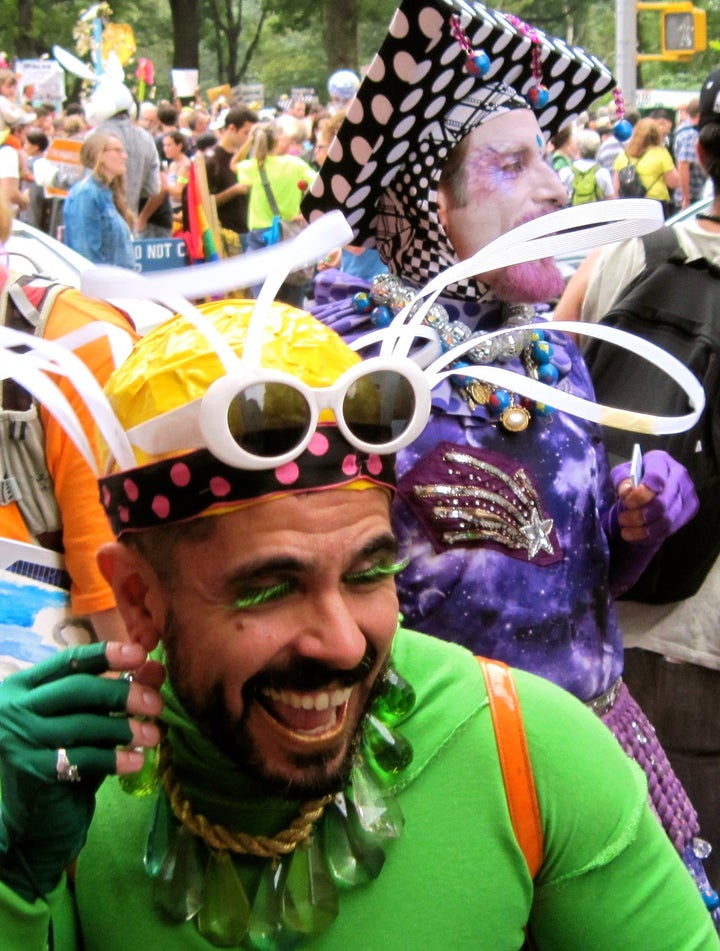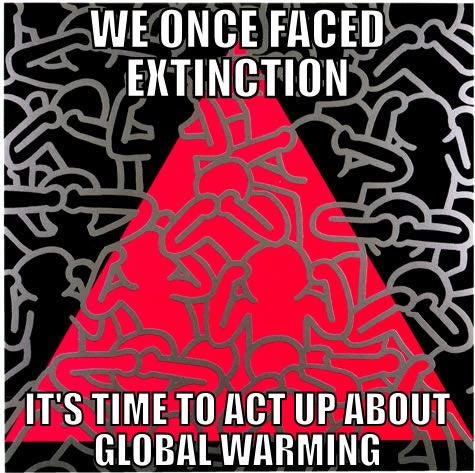
LGBTQ+ people joined the People’s Climate March in September 2014 as part of the Queers for the Climate group
I am not an environmentalist in the traditional sense, yet I am very concerned about climate change. I see global warming as an LGBTQ issue, one that affects us specifically. It is also an issue that needs our help. Based on our background and the diversity of ways we view the world, we have essential skills and experience to bring to this large and often overwhelming problem.
In exploring climate change, I have been curious about LGBTQ responses to the problem. First off I needed to identify how climate change specifically affects some of us. One of the keys is to recognize that climate change is a human rights issue that affects immigrants, policing, access to emergency relief, and equality. Here are two examples:
LGBTQ Seniors and Climate Change
While I am not yet a senior citizen, that is coming up one day in the near future. I hated air conditioning ever since I lived in Memphis and endured it freezing my nipples off so I had to escape into the blazing muggy outdoors to defrost. Also AC is expensive and energy intensive. More severe and frequent heatwaves are predicted. Elderly people are affected by heatwaves which can lead to severe illness and death.
As a gay man, I do not experience the same equality as heterosexual citizens and residents. My job and career got disrupted because of my orientation. I don’t have a big pension coming my way. I do not have children or the prospect of children, while many if not most heterosexuals do. Often children help look after aging parents.
There are real risks from climate change as I get older. I don’t have children checking in on me to make sure I am ok during heatwaves and other extreme events. Also, I live in a rural part of the USA and worry about discrimination in the healthcare industry.
Homeless LGBTQ Youth and Climate Change
Up to 40 percent of the homeless youth population in most cities. They often avoid shelters. Many shelters are private ventures run by churches. There is often no knowing how church folk will receive LGBT+ kids.
Also, most shelters are gendered spaces: boys to one side, girls to the other. What about transgender youth? Gender non-binary and genderqueer youth? LGBTQ+ youth often do not like going to these shelters.
On a warming planet we see more frequent and extreme weather events like Superstorm Sandy and Hurricane Katrina. Where do these kids go when shelter becomes a matter of life or death? Are we developing shelters that are specifically and intentionally friendly towards LGBTQ+ youth?
What’s a Queer to Do?

It is one thing to recognize a problem, but what can we do to address it? Here are some suggestions:
a. Break the collective silence around climate change and do it in a creative way. Much like during the early HIV/AIDS Crisis when the government could give a damn about gay men and people of color (gay and straight) suffering with GRID (gay related immune deficiency as it was first called) when virtually no one was talking about or covering the epidemic, today with climate change I am reminded: Silence=Death. We need storytellers, artists, people concerned with human rights, creative queer communicators to tell the story of climate change and to engage the public.
b. Work on local and regional resiliency and community building. Develop a list of all the LGBTQ+ seniors in the community. Check in with them before and after storms and heatwaves. Open up community centers and LGBTQ+ friendly spaces as cooling centers during the hottest days of the year. Help with retrofitting homes with what will be cheaper energy efficient technology. Help LGBTQ+ people who are marginalized because of poverty, race, gender identity/expression with adaptation including growing food and water collection.
c. Recognize that climate change results in migration and immigration and that within that population there are LGBTQ+ people who are also affected by homophobia/transphobia. They may be deeply marginalized in their own families and among fellow migrants. Provide services, language classes, community, and opportunities to connect w/ LGBTQ+ migrants.
d. Recognize that during extreme weather events political leaders override existing policing practices when they declare a State of Emergency. There are curfews, forced evacuations. As a result, there are opportunities for human rights abuses and injustice. This directly affects LGBTQ+ people who are poor and/or homeless. Educating first responders, political leaders, and police about LGBTQ+ populations and reporting any and all abuses of power are essential.
e. Educate ourselves about climate change as a human rights issue and apply for funding for adaption in our communities to specifically reach out to LGBTQ+ folks to educate them and convince them that they have skin in the game.
Storytelling Superpowers
The power of stories is one that we learned during the HIV/AIDS Crisis. This included visuals like the AIDS quilt and the red HIV/AIDS ribbon (which inspired countless other ribbons.) During the Transgender Day of Remembrance, we hear stories that move us to tears and to action.
I use my creativity to help people see that climate change affects pets, coffee, wine, a picnic in the park, policing and incarceration, and much more. I do not think anyone needs to become an environmentalist to be concerned about climate change. Rather they need to understand that something they are already passionate about is threatened by climate change.
I also think comedy has a role to play—not mocking people dismissive of climate change—that is not really that funny and just ends up with people feeling smudge because they recognize climate change is real. Rather comedy is a queer response to climate change. It immediately instils the conversation with hope and it relaxes people so that they can hear what they often filter out.
Most heterosexuals talk about climate change in a way to stir up fear, shame, and anger. We can use comedy and storytelling instead to inspire curiosity and engagement.
We must talk about climate change as LGBTQ+ people. In other words, “queer” the climate discussion. And with that queering we can insert mirth, play, beauty, and art. What we lack in addressing climate change is a lack of imagination. While LGBTQ people do not have exclusive rights to creativity, we have already demonstrated our abilities to use creativity, camp, and art in fighting oppression changing the public discourse.
Here is my own contribution to the growing body of campy comedy addressing climate change.
